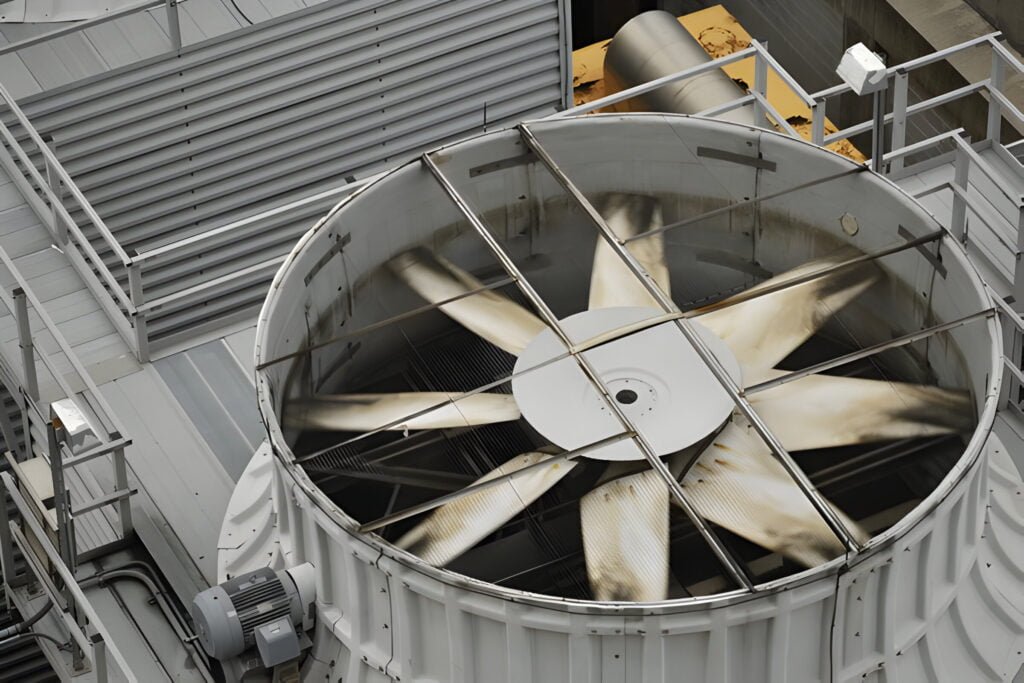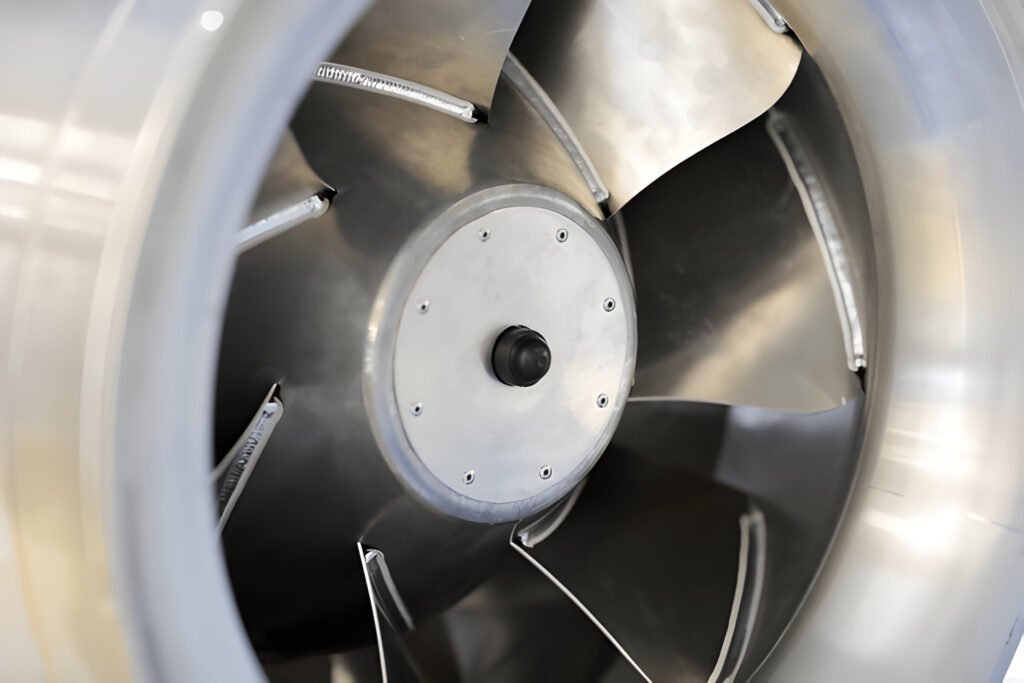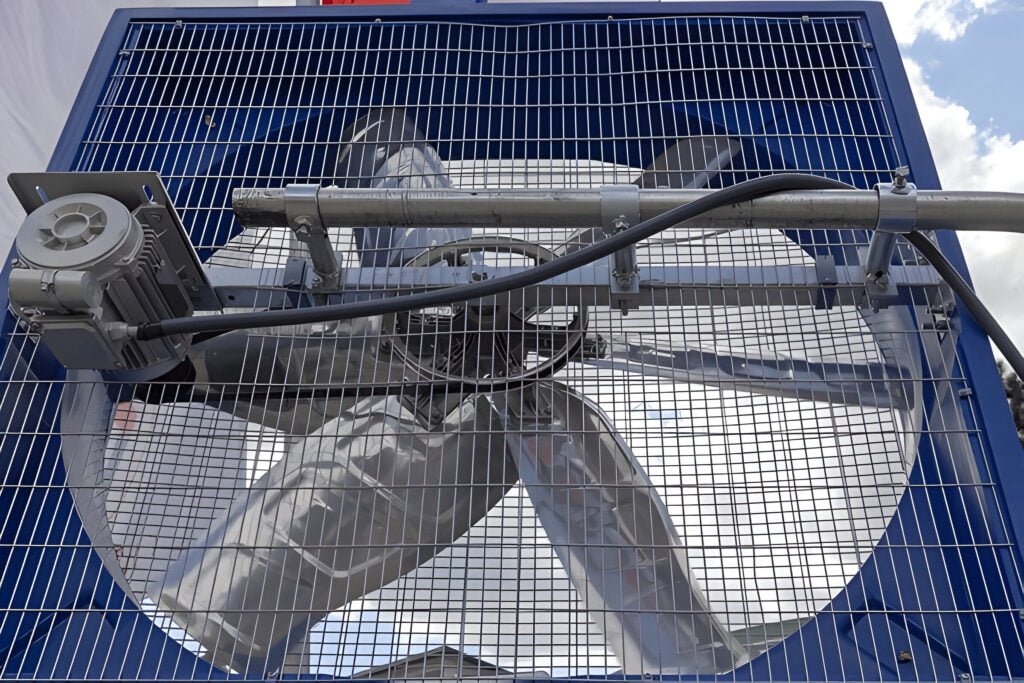What Are Axial Fans
Axial fans move air parallel to the fan blade axis. Used for general ventilation, cooling, and exhaust. Compact, efficient airflow in a straight line.
Read More



The stall region of an axial fan is the operating range at very low flow rates where flow separates from the blades, causing a dramatic drop in pressure and efficiency.
Stalling in axial fans occurs when airflow separates from fan blades, causing performance and efficiency loss. This happens when the angle of attack between incoming air and fan blades becomes too steep, detaching smooth airflow from the blade surface. The result is a sudden drop in the fan’s air movement and pressure generation capabilities.
Axial fan blades operate at specific angles relative to incoming airflow. This angle of attack affects fan efficiency. Excessive angles can cause stalling.
Flow rate reduction or pressure increase leads to excessive blade angle of attack. Decreased flow rate changes air velocity vector, increasing the angle. Rising system pressure alters airflow patterns, also increasing this angle.
Large angles prevent airflow from following blade curvature, causing separation from the blade surface. This separation creates turbulence and reduces fan efficiency. Performance drops and noise levels increase.
Physical factors beyond excessive blade angles can disrupt airflow and cause stalling in axial fans. Blade fouling occurs when contaminants accumulate on fan blades, altering their aerodynamic profile. This buildup increases surface roughness, disrupting smooth airflow and potentially triggering stall conditions.
Erosion poses a risk in harsh environments. Abrasive particles in the airstream wear down blade surfaces over time, changing their shape and effectiveness. This erosion creates uneven surfaces or thin blade edges, compromising fan performance and increasing stall susceptibility.
Mechanical misalignment contributes to stalling when fan blades aren’t properly aligned with airflow. This misalignment results from manufacturing defects, improper installation, or operational damage. Even slight misalignments create turbulence and uneven pressure distribution across blade surfaces, leading to localized or full-blade stalling.
Fan oversizing and sudden system resistance changes can cause axial fan stalling. Oversized fans operate inefficiently, far from their design point, increasing stall risk. These fans often run at reduced speeds, placing them in unstable operating regions prone to stalling.
Abrupt damper or valve closures and rapid material buildup in filters or heat exchangers increase system resistance. This forces fans to operate outside their stable range, inducing stall conditions. In parallel fan configurations, failure of one fan may overload remaining fans, pushing them into stall regions.
Rotating stall and surge constitute primary aerodynamic instabilities in axial fans. Rotating stall forms when small stalled airflow regions develop on fan blades, rotating around the annulus at a fraction of fan speed. This phenomenon reduces fan performance and generates vibrations and noise.
Rotating stall occurs when fan flow rate drops below a critical value, often triggered by non-uniform inlet conditions or blade geometry inconsistencies. Rotating stall cells create periodic pressure fluctuations, potentially damaging the fan over time.
Surge represents a more severe instability, characterized by rapid, large-scale flow reversals through the entire fan. It occurs when the fan fails to maintain a stable operating point due to excessive backpressure, resulting in violent pulsations that can cause immediate damage to the fan and connected systems.
Unbalanced fan blades increase stalling risk in axial fans. Improper blade balance creates uneven airflow and pressure distribution across the rotating assembly, leading to vibrations, increased bearing stress, and potential stalling.
Blade imbalance often results from manufacturing defects, wear, or operational damage. Erosion, foreign object impacts, and uneven dirt accumulation worsen the issue. During rotation, these imbalances cause velocity and pressure fluctuations, disrupting optimal airflow.
Unbalanced blades are more prone to localized stalling. This occurs when the angle of attack becomes too steep on certain blade sections, causing airflow separation. Resulting turbulence can spread to other blades, potentially triggering a full stall.
High back pressure disrupts airflow across fan blades, causing axial fan stalling. This occurs when system resistance exceeds the fan’s capacity. Clogged filters, obstructed ducts, and closed dampers restrict airflow, increasing resistance. System modifications like extended ductwork or added components can also raise resistance. Outdoor installations may face strong headwinds, creating excessive back pressure.
Increased back pressure alters the blade’s angle of attack, potentially leading to flow separation. This results in performance drops, reduced efficiency, vibration, and increased noise. Prolonged stalling can damage the fan and connected equipment.
Inadequate maintenance negates proper system design benefits and increases axial fan stalling risk. Neglecting regular upkeep leads to various issues.


Axial fan stall causes a sudden drop in pressure rise and airflow delivery. The pressure difference across fan blades decreases rapidly, reducing air movement efficiency. Airflow output declines by 30% or more as blades fail to maintain proper flow patterns, leading to reverse flow and recirculation within the fan housing.
This performance loss impacts system functionality.
Axial fan stall reduces efficiency and increases power consumption. Efficiency drops as the fan converts less electrical energy into useful airflow. The fan works harder but produces less output, wasting energy and raising operating costs.
Power consumption rises during stall. Electricity usage spikes as the motor struggles against disrupted airflow. This increased power draw affects energy bills and can lead to overheating and premature component wear.
Flow reversal occurs as axial fan stall develops. Airflow in some blade passages reverses direction, moving from outlet to inlet. This disrupts normal fan operation and creates system instability.
During flow reversal, air pockets move against the intended flow direction. This causes pressure and velocity fluctuations, leading to vibrations and noise. Fan performance becomes unpredictable, making consistent airflow difficult to maintain.
Unsteady off-design operation happens when the fan operates outside its intended performance range. Rapid changes in flow patterns, pressure fluctuations, and irregular blade loading occur. This instability can cause fatigue damage to fan components and reduce system reliability.
Axial fan stall induces structural vibration, cyclic loading, and increased noise generation. Vibration levels rise dramatically during stall, potentially causing fatigue damage to fan blades, bearings, and other components.
Stall conditions create fluctuating forces on fan blades due to airflow separation and reattachment. These alternating stresses lead to material fatigue and possible blade failure if not addressed.
Noise levels increase substantially during fan stall. Irregular airflow patterns generate intense pressure fluctuations, resulting in tonal and broadband noise. This noise can pose safety risks in industrial settings and may violate workplace regulations.
Prolonged stall conditions cause severe damage to axial fans and associated equipment. Repeated stress from stalling leads to premature wear on components. Blades are most vulnerable, experiencing excessive vibrations and fluctuating loads. This results in blade deformation, cracking, or failure over time.
Motors and bearings face increased thermal and mechanical stress during stalls, potentially overheating and breaking down prematurely. Fan hubs, shafts, and mounting structures may sustain damage from intense vibrations and uneven loading.
Stalling impacts connected systems. Ductwork and downstream components suffer from erratic airflow and pressure fluctuations, leading to fatigue and leaks. In extreme cases, catastrophic failure of the entire fan assembly or connected equipment can occur.


Axial fan selection requires precise calculation of system airflow and pressure requirements. Determine the necessary airflow rate and static pressure, accounting for potential demand fluctuations. Safety margins accommodate unexpected system condition changes.
Maintain adequate stall margin by operating axial fans 10-15% above the stall line on the fan curve. Monitor system resistance and adjust fan speed or blade pitch to keep the operating point within this stable range.
Regular maintenance and cleaning of axial fans prevent stall and ensure optimal performance. Schedule routine inspections to check for wear, damage, or debris accumulation on fan blades and housing. Clean blades thoroughly, removing dirt, dust, and foreign objects that disrupt airflow and cause stalling.
Casing treatments add grooves, slots, or recirculation channels to the fan’s outer casing. These modifications reduce tip leakage flow and improve stall margin by redirecting airflow and decreasing pressure differences between blade suction and pressure sides.
Stabilizing fins are small, stationary blades installed upstream or downstream of the main rotor. They straighten airflow and reduce turbulence, making fans less susceptible to stall.
Vortex generators are small protrusions on blade surfaces that create controlled turbulence. This turbulence energizes the boundary layer, delaying flow separation and stall. Engineers apply these to specific blade areas where stall typically initiates.
Variable pitch systems alter blade angles during operation. This optimizes fan performance across different flow conditions, maintaining efficiency and preventing stall onset as operating conditions change.
Air injection introduces high-pressure air near blade tips or along the fan casing. This energizes the boundary layer, delaying flow separation and stall. It proves effective during transient conditions or sudden flow changes.
Bleed valves manage airflow and pressure by releasing excess air from the compressor. This reduces load on fan blades, maintaining stable airflow and preventing stall progression. Bleed valves are particularly useful during low-flow conditions or rapid changes in operating parameters.


Optimized blade profiles expand the stable operating range of axial fans. Airfoil shapes that maintain attached flow over various conditions are crucial. Balance blade camber, thickness distribution, and leading edge geometry for optimal performance.
Matching fan characteristics to system resistance curves prevents stall and ensures optimal performance. Consider both fan performance and system resistance curves when selecting and installing axial fans. Fan curves show pressure and flow rate changes at different operating points. System curves represent pressure required to move air through the system at various flow rates.
Choose a fan that operates near its best efficiency point when intersecting with the system curve. This intersection is the fan’s operating point. Fans with curves mismatched to system needs risk operating in the stall region. Adjust system curves by modifying ductwork, adding dampers, or changing filters. Alternatively, select a different fan or use variable speed control to shift the fan curve.
Tip clearance and leakage flows impact axial fan performance and stall prevention. Minimize the gap between blade tips and fan casing to reduce air leakage and improve efficiency. Optimal clearance typically ranges from 1-2% of blade span, affecting overall performance and stall margin.
Reduced tip clearance decreases tip leakage flow, which occurs when high-pressure air escapes from the blade’s pressure side to the low-pressure suction side. This leakage creates vortices that can cause flow separation and stall. Minimizing clearance enhances pressure-generating capability and delays stall onset.
Inlet flow conditioning and guide vane design reduce stall in axial fans. Uniform, stable airflow entering the fan minimizes stall risk. Bell-mouth inlets or carefully designed ducting achieve smooth air entry.
Axial fan stalling produces a loud, disruptive noise. The sound is typically described as a roar or rumble, often 10-20 decibels louder than normal operation. This sudden increase in volume can be jarring and potentially harmful to hearing.
Axial fan stalling can indeed cause permanent damage. Prolonged stalling may lead to overheating, increased vibration, and excessive wear on bearings and components.
Visual indicators of imminent axial fan stalling include blade flutter, increased vibration, unusual noise, and reduced performance or airflow. Monitoring these signs can help prevent potential damage to the fan system.
Axial fan stall recovery time varies from seconds to minutes. Quick recovery occurs when causes are promptly addressed.
Fan blade materials impact stalling likelihood. Lighter materials like carbon fiber or aluminum reduce inertia, enabling quicker response to changing conditions. Stiffer materials help maintain optimal blade shape under stress, potentially decreasing stall risk.